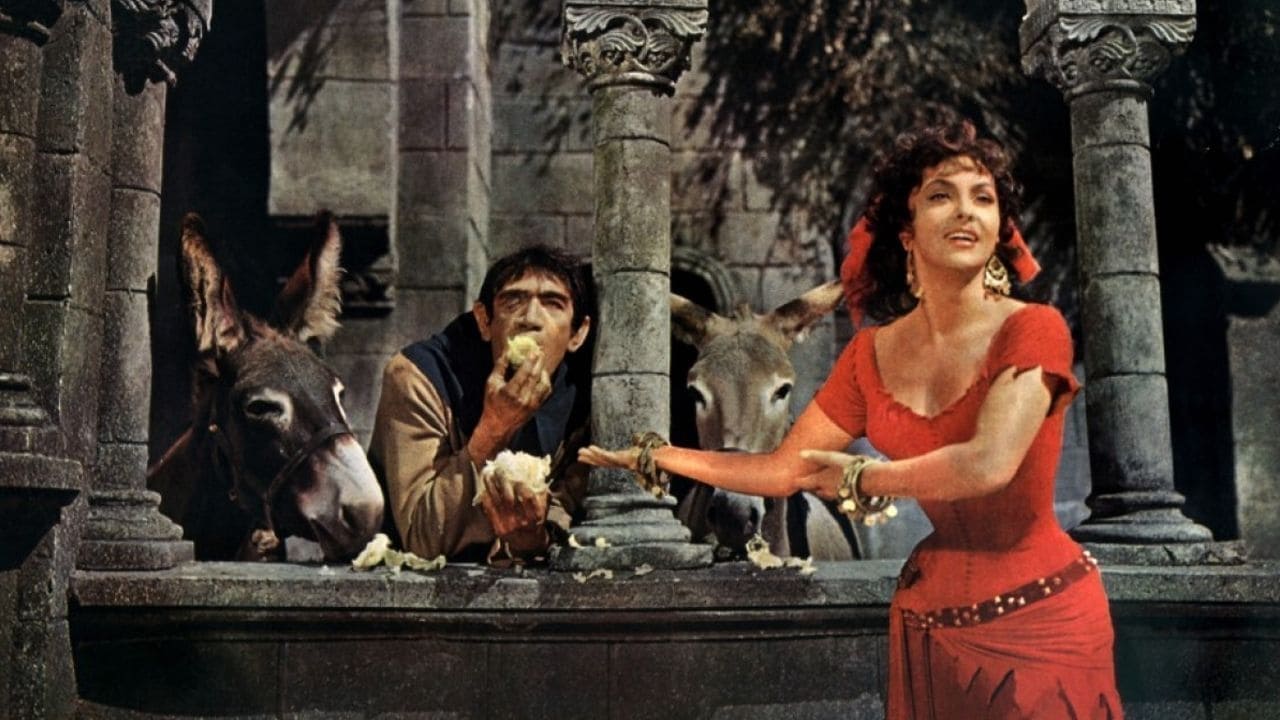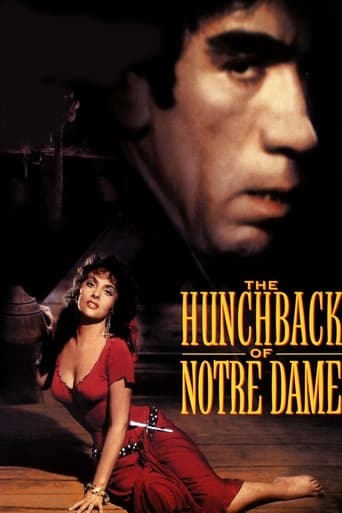Maidgethma
Wonderfully offbeat film!
CommentsXp
Best movie ever!
Sexyloutak
Absolutely the worst movie.
Robert Joyner
The plot isn't so bad, but the pace of storytelling is too slow which makes people bored. Certain moments are so obvious and unnecessary for the main plot. I would've fast-forwarded those moments if it was an online streaming. The ending looks like implying a sequel, not sure if this movie will get one
PWNYCNY
This is a movie that has all the trappings of an epic, but isn't. But it is still a credible rendition of the Victor Hugo classic, with Gina Lollobrigida giving a strong performance as Esmeralda. The weak part of the movie is Anthony Quinn's performance as Quasimodo. Mr. Quinn's portrayal is not believable. Quasimodo is supposed to generate feelings of pathos; that does not happen in this movie. As a result, the plot becomes flat. The intensity of the relationship between Quasimodo and Esmeralda is lacking. Between Mr. Quinn's mumbling of his lines, and the treatment of the poet Gringoire as a buffoon, the movie teeters on the brink of cinematic collapse. Yet, it is saved by staying faithful to the original story and by good performances by some of the supporting cast, as well as by the essential power of the original story. The story of the hunchback and the gypsy girl is classic; read the book.
Claudio Carvalho
In 1482, in the Feast of Fools in Paris, the deformed bell ringer Quasimodo (Anthony Quinn) is elected the King of Fools. After the party, the evil alchemist Master Claude Frollo (Alain Cuny), who has a repressed lust for the kind gypsy dancer Esmeralda (Gina Lollobrigida), orders his servant Quasimodo to abduct the beautiful youngster. However, she is rescued by Captain Phoebus (Jean Danet) and Quasimodo is sentenced to be whipped in the square of Notre Dame and Esmeralda gives water to him. Later Esmeralda goes with Captain Phoebus to a room in an inn to spend a night of love together. However, Frollo is stalking her and uses her stiletto to stab Phoebus on his back, and Esmeralda takes the blame and is sentenced to be hanged. But Quasimodo brings Esmeralda to the sanctuary of Notre Dame and expresses his love for the gypsy."The Hunchback of Notre Dame" is one of the cruelest romances of the literature and cinema history in a dark age in French history. In this version of this sad tale of injustice, Anthony Quinn is awesome with a memorable performance and Gina Lollobrigida is perfect in the role of the seductive gypsy. My vote is seven.Title (Brazil): "O Corcunda de Notre Dame" ("The Hunchback of Notre Dame")
bkoganbing
In this third version of The Hunchback of Notre Dame we get a story far closer to the truth of Victor Hugo's classic novel. Unlike the productions done starring Lon Chaney and Charles Laughton, this one was done in France by the French who took pains to remain faithful to the version Victor Hugo wrote. Note the title in the original French and note it's the cathedral not the hunchback who is the center of the story. That allowed Italian film star Gina Lollobrigida to be billed first and then Anthony Quinn as the hunchback. No doubt about it Lollobrigida is the sexiest Esmerelda going, she makes both Patsy Ruth Miller and Maureen O'Hara look like nuns. Then again she was who the movie going public was paying to see.This is not to take anything away from Anthony Quinn who seems to extend his role as the brutish strong man in La Strada into his portrayal of Quasimodo. Although Charles Laughton's performance is my favorite, this does not denigrate Quinn in any way. The rest of the cast is made up of players from the French cinema. I particularly liked Jean Tissier as the 'Spider King' Louis XI. It's a subtle piece of acting and you can see why this was no man to trifle with.The Hunchback of Notre Dame is a tale of innocence. Quasimodo's to be sure, but even the sexy and voluptuous Esmerelda. She may know all about sex, but she's pretty ignorant in the ways of the political world. Both protagonists are used by forces and people they cannot comprehend.This version of the Victor Hugo classic has its supporters and they should support this great retelling of a classic tale.
dbdumonteil
Non -French users may find it hard to believe it,but Jean Delannoy is despised by almost everybody in his native country.The NOuvelle Vague clique,on H.M. JL GOdard's service ,was always putting him down.That was (and is) certainly unfair cause Delannoy made two great "Maigret" and some of his works "la Symphonie Pastorale " Dieu A Besoin des Hommes" or "les Amitiés Particulières" are certainly worth a watch.His "secret de Mayerling" which is hard to find is certainly interesting too.Lit classics were also one of his favorite genres: abetted by Jean Cocteau,he updated "Tristan and Iseut" (as "l'Eternel Retour" ).Later he would transfer Madame de La Fayette 's "La Princesse de Clèves" (1961) with commendable results -the critics slagged it off- Here he tackles "Notre Dame de Paris" ,with a big budget (wide screen , color and an international cast were not so common in 1956 in France).His version is academic ,as would be Le Chanois's -another Bete Noire of the Nouvelle Vague- "les miserables " (1958).It's icily impersonal ,and it's the actors who save the movie from tedium:although too old ,Lollobrigida has beauty,charm,sensuality and even wit going for her;Quinn is a good -but not as outstanding as Charles Laughton-Quasimodo;Robert Hirsh is excellent as Gringoire;On the other hand,Jean Danet is a mediocre Phoebus.Although inferior to Dieterle's version ,Delannoy's work is more faithful to the novel (the ending notably) but there's a problem concerning Claude Frollo:why has he become a layman?Part of the reason might be found in the director's belief.Jean Delannoy is a true believer: in "Dieu a Besoin des Hommes" he showed spiritual concern.And recently,he released two religious movies in a row " Bernadette" (Soubirous) and "Marie de Nazareth".So maybe ,he changed Hugo's character because it was unbearable to him that a priest should desire a woman.Alain Cuny,whose portrayal of FRollo is a bit monotonous, had a brilliant career ,from Carné's "Les Visiteurs du Soir" to Fellini's "La Dolce Vita" and "Satyricon".

